How to Stand Out at PAX and Game Expos
A Guide for Indie Dev Exhibitors
If you are going to PAX or another game convention to exhibit your game you need to stand out. Being like everyone else or “normal” is like getting a headshot. It will kill your event experience and you don’t get to respawn until the next show. Don’t let normal kill you.
Knowing how to stand out at a gaming expo is essential, however while many people may have an idea on how to do this, few execute. Look, promoting your game at a conference is a lot of work and it’s easy to just go through the motions. Unfortunately, anything that is easy just doesn’t cut it. At the end of the day, it’s about exposure for your game and making an impact on people. So the real question is what are you doing so that happens?
It Starts with Location
Standing out starts before you even think about setting up your booth. Setting a budget, knowing what to expect for exhibitor costs, and reaching out to events in advance can give you a huge advantage. Bigger isn’t necessarily better, but location is everything. Before booking your booth, ask the venue for a floor layout and make sure to pay close attention to these three things; entrances and main aisles, corner booths and well established exhibitors.
Entrances and Main Aisles
Being reasonably close to these areas are essential. For the most part, you want to be as close as you can to the source or flow of traffic. This will ensure that you get the most eyeballs as possible looking at your booth. Being right next to entrances may limit some exposure as people may overlook and pass you when they first enter. The main benefit is you’ll likely get more traffic than if you were tucked in the middle of the chaos or in a far off corner.
Another perk to being next to an entrance is they likely offer more floor space around your booth. That means more standing room for people and gives you the potential to generate a crowd without event staff having to break it up.
Corner Booths
Ever wonder why entrances to most pharmacies are on the corner of the building? It was Walgreen’s that actually started this. Basically they thought this small change to their stores in high traffic areas would produce more foot traffic and lead to more sales. The results were astonishing and eventually the change in design was adopted by nearly every major pharmacy.
The point of the story is simple. Corner booths mean more traffic. If you can, get a corner booth.
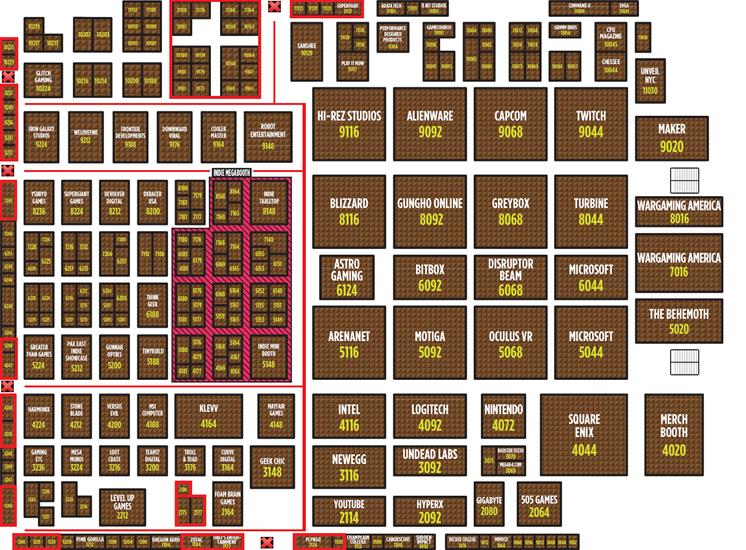
The areas boxed in a red outline show ideal booth locations. Red “X”s indicate entrances and the red lines are main aisles
Well Established Exhibitors
Find companies that are likely to draw a lot of attention. This can give you a slight edge and make your life a lot easier as you can capitalize on their traffic that spills over to your booth. You can always try to ask the conference where certain exhibitors are located or if large chunks of areas are taken by a single exhibitor too. Another alternative is if a well established exhibitor always gets the same booth location, try to see if spots next to them are available.
Designing Your Booth to Stand Out
Designing your booth is no simple task. A lot of thought and detail needs to be considered so your booth is designed in a way that is welcoming and engaging. It’s understandable that you may not have all the resources to help you stand out, so that’s when relying on friends or rental houses can help. Friends are great, but they may not have everything you need. Rental houses will have everything you need, but aren’t that great cost wise. If you go through a rental house, make sure to ask them about about every possible fee they may have. There is nothing worse than finding out your $150 a day rental just doubled because of something you weren’t aware of. Last but not least, there is Best Buy having a good return policy. Not encouraged, but it’s still an option.
At this point, you should already have your budget set, the equipment you’ll need and the size of your booth. Typically standard booth sizes are going to be a 10x8 or 10x10 space. Getting into larger spaces gives you more flexibility but that may equate to more dollars. Regardless of the size, the principles below still apply. You just have to be a little more creative with a smaller booth.
Your booth’s purpose
First and foremost, your booth has a purpose. Yes, it’s to promote your game, but more importantly what is your booth’s intent? If you are promoting a VR game, then your booth design is going to be completely different than a booth featuring a multiplayer game. Designing your booth to stand out is important, but if you don’t focus on the booth’s intent and how it relates to the game and user experience, then your booth may be doing more harm than good.
Your booth is not an obstacle course
10x10 isn’t much space and the low dividers on both sides can make it difficult for people to move freely. Any exhibitors that rush in and plop a table at the front of their booth are creating a box and setting themselves up for failure. Add personal stuff, banner stands and other promotional materials that could serve as obstacles, then you may have inadvertently created a new MXC course. You want everything to have it’s place and promote flow as it will save you time and frustration.
Be different
Different is going to be what people remember you for. Different will get people to talk about your game. Different will get people to play your game and engage with you. Yes...it was intentional to hammer that into you. So start thinking...different.
Ok, let's further discuss what “different” means. A great exercise is to start listing out the things that you would expect to be normal from other booth setups. Posters, banners, display monitors, materials to hand out on tables, etc. Chances are, if whatever you think is the norm, it is. So either don’t do that, or do it differently.
Now, it’s not like you have to go crazy with your ideas, but your ideas need to be creative and obviously stand out. One way to approach this is to think about big and shiny things. Everyone loves big and shiny things.
Having things hang above your booth or stand taller than the crowd is a great way to get attention and to be seen from a distance. As long as you can get something to stand at least 7-8ft you will have a huge advantage over others at the show. Just make sure it’s safe and doesn’t get flagged by the event’s staff when you’re setting it up. This may sound a little far-fetched or impractical but you’re in the business of making impressions on people. Not only that, but people have a significantly easier time remembering things if they can associate it with something that stood out. It’s one of the few ways the human brain remembers things.
Lighting is key
If you have anything like large banners or posters then get some inexpensive lighting to illuminate them. This is essential for anything against the backdrop of your booth, even if your banner contrasts the dark drapes. It doesn’t have to be elaborate either. Just a simple light bulb fixture with a clamp can make your banners really pop out. Lighting your booth this way adds depth. Think about it, if your booth looks bigger than it is by adding more depth you make your booth more engaging, welcoming and professional looking.
Lighting can also help you be different. In addition to depth, it can also be used to get people’s attention. Think of how well emergency vehicle lights or lights on a marquee work to get people’s attention. If it’s relatively bright and it blinks, people will naturally be drawn to it. Just don’t go overboard...it’s not like you’re running a laser light show.
Keep it simple
Your booth needs to attract people and promote engagement all while being relatively simple. Following this concept will help make your job a lot easier. Here are some great examples of how these concepts are well executed.
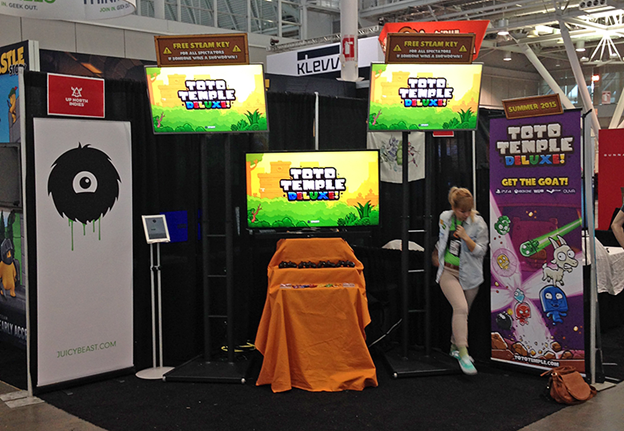
Just from looking at the setup, you can tell that Toto Temple Deluxe by Juicy Beast Studio is a multiplayer game. No, it wasn’t the controllers that gave it away either. This layout shows that they wanted to maximize as much space as possible. To garner more attention, they put two additional displays on tall stands so more people from a distance could see the action going on.
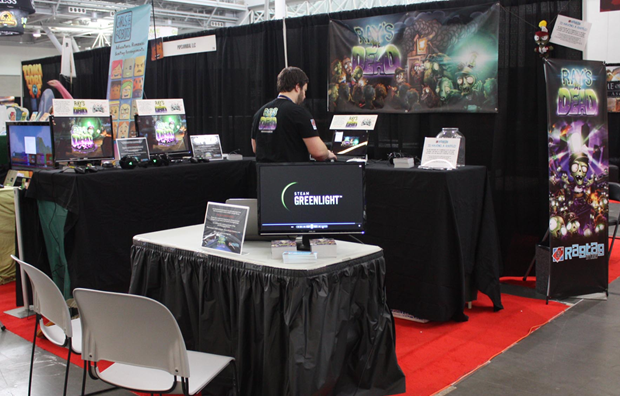
Ray’s the Dead by RagTagStudio had a fairly simple corner-booth layout. Using high tables in the back and left corner and a lower table in front, they maximized their space for as many people to play the demo as possible.
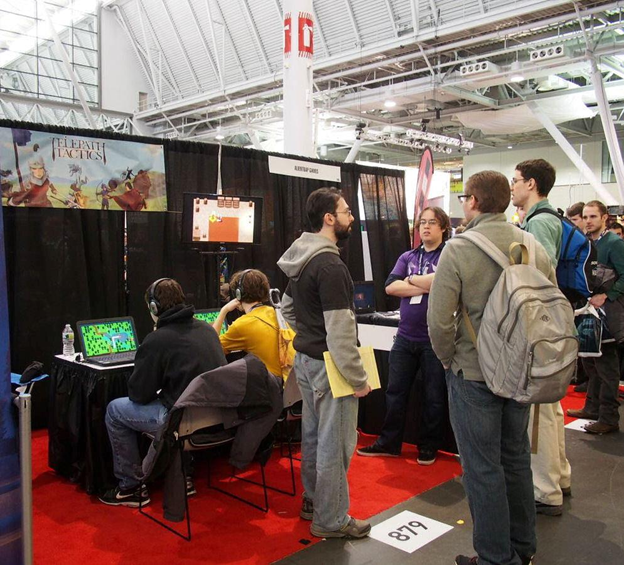
Telepath Tactics by Sinister Design was the one of the very few “non-corner” booths that did a great job of keeping their space open and easy for people to play the game. Even with the low level pipe and drapes still up, it’s relatively easy to move around the space and engage with people.
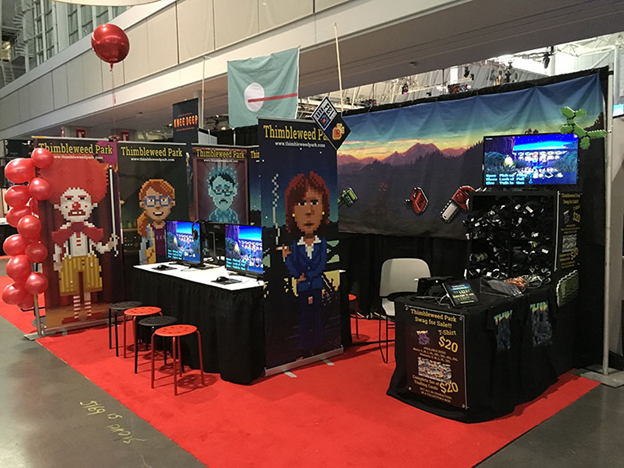
While a little more elaborate and larger in size, Thimbleweed Park did an amazing job with their setup. Using stools instead of chairs allowed them to maximize the number of people seeing the game, whether they were playing or watching. The table off to the right served multiple functions; another spot where people could play the game on a tablet, a place to get more info about the game or allowed people purchase merch like t-shirts that were nicely stored in an easily accessible bin. They even used balloons tastefully to help stand out, as they are attached to the clown poster who is...holding a balloon. Over all, very well executed.
In addition to being welcoming and engaging, these booths have a specific flow and are also easy to navigate. Everything has its place and there are no unnecessary or distracting items lying around. That’s why keeping your booth simple and clean is a great strategy to make everyone’s experience better.
Each booth listed also had a fairly clear intent. Some booths wanted a more immersive experience for their players so they provided a chair and headsets. Others were showcasing a multiplayer game which relied heavily on large, elevated monitors to help get attention. These details might seem like a moot point but every little detail matters and people will notice them.
Here’s a quick exercise for you.
While these booths are simple and stand out in their own way, which ones do you feel could stand out more? Why?
What changes would you make to give them a little edge and stand out more?
Creating a Game Plan
Creating a game plan detailing what you will do it is essential. It not only prepares you, but allows you to stay focused and gives you the ability to change on the fly while remaining on track with your initial goal. A great way to do this is make a template that is broken down into categories. Booth set-up, equipment, pitch and 1st and 2nd goals are just some ideas. Jot down what you plan to do and see how well you can stay on course. This will mainly be a rough outline, but below are more detailed ideas to consider when making your plan.
Be prepared and creative - Have your pitch down pat before the show. Know exactly what you are going to say to encourage people to play your game. Most important, keep it short and sweet. Time is everything. Once again, be different with your approach too. What is something that you can do that not only gets people’s attention but something that they will remember you by? A simple gesture? A play on words that perks their ears? The possibilities are endless. You can even have a list of ideas you can try day one at the show and see which one gets you the best response. Whatever works best, use that. Be creative and have fun with it.
Actively engage with people - Now that you have your pitch down, you need to be aware of how you are going to say it. The how is very important. Body language, tone of your voice, facial expressions can make a strong or poor impression on people. If you greet someone slumped over in a chair with a low and tired voice, most likely they aren’t going to get excited about your game. Stay on your feet as much as you can and actively engage with everyone. Be polite though. Don’t just shove a tablet or controller into their hands. Spend a few moments to get to know them a little and then have them play. Even as you get tired during the last day of the show, keep these things in mind. It might be tough but work through it, it’s well worth it.
Activities = Engagement - This idea came from Alex Nichiporchik of TinyBuild who posted a great, concise guide to game conventions on Gamasutra. (It’s #6 in case you want to see what they did for their activity).
Activities are a great way to keep people engaged without having to do as much work. It can also be a great way to build a crowd. Last year at PAX East, Alice & Smith showcased The Black Watchman a “permanent alternate reality game” which incorporated puzzle solving gameplay that would provide clues to unlock a real briefcase that was sitting on their table. Their booth was fairly simple. With only a monitor, some promotional materials, briefcase and a black banner against the black drapes, they had something a lot of other booths didn’t. A crowd.
On the other side of the coin though, an activity could serve as a distraction. The point of having a booth is to get people to play your game. So if you plan on having an activity to increase engagement and potentially get a crowd, make sure the activity relates to your game to some extent. That is mainly why The Black Watchmen was so successful in getting the attention they did. While their activity was directly tied to their game, having some type of connection to your game is essential.
The activity could be as simple as a player given a clue or mission prior to playing the demo. This creates intrigue and a challenge while still giving the player the option to opt in for the mission or not. This idea is tied directly to the game itself, but the impact is likely to be more focused on the individual playing the game. Taking a broader approach like TinyBuild did, their activity was definitely broader based, but didn’t tie into their games or their brand, which makes sense because of their booth’s intent. You could even go a step further and incentivise the completion of either of these activities with a prize (Steam Key anyone?).
Think of these two activity ideas as two sides of a spectrum and if you choose an activity, decide if you want it to be more broad or focused. Ultimately though, the objective of the activity is so people can be engaged and easily recall your game.
An activity by itself won’t cut it though. Having an activity in addition to everything else you planned can increase your chances of engaging others.
Here’s an idea! If you are really clever, see if you can create an activity that relates to something people do on a daily basis but is associated to your game somehow. Then every time people do that activity, they’ll remember your game. Talk about subliminal messaging!
Have materials ready
If you have posters, business cards or flyers, have them easily accessible at all times. There is nothing worse than shuffling through boxes searching for these things when people ask for them. It wastes their time and yours.
What NOT to do during the show.
Now that you have your game plan down pat...let’s focus on what not to do during the show.
Eat in the booth - This is a tough one not to do but there are a couple of reasons why it’s not good. The first one is fairly obvious. Nobody wants to talk to someone with a mouthful. Not to mention, typically when people are eating they are hiding behind stuff. If you are hiding then you’re not hanging with future fans.
Sit back in your booth - Similar to eating, if you are sitting down in the back of the booth somewhere, you’re not meeting people interested in your game. Do whatever you can to always be in the front of your booth.
Have a candy bowl or cheap swag - This is generally a waste of money and people don’t care much for it. Even worse, you’ll find yourself relying on the bowl to start up a conversation which is a poor way to start any conversation.
As for swag, if you can help it stay away from it. It costs money and even if it is good swag, there usually isn’t a way to track or guarantee how much of an impact it will have on your game. People mainly come to game conventions to play games, not collect a bunch a free crap (though I’m sure some will beg to differ).
Thoughtlessly making and handing out flyers - While some people may feel that flyers are a waste of money and paper, they can still can be a helpful tool if used properly. With that said, please don’t hand out flyers to the masses without any interaction. Simply handing out flyers to people walking by almost guarantees that the flyer will do nothing but end up on the showroom floor. Not only that, but unless the flyer has some type of specific call to action that can be tracked (like a “secret” landing page on your website), it’s impossible to attribute any results they may have generated. If you are thinking about making flyers but don’t plan doing any of the above mentioned things...save your money.
Quick Energy Hacks
Ok, so this section may deviate a little bit from the whole “standing out” concept, but the point is if you’re not refreshed or energized, then you’re not going to be able to physically or mentally stand out.
These quick energy hacks don’t consist of power drinks loaded with caffeine and sugar. If those work for you, great! If the idea of consuming copious amounts of caffeine and sugar until you crash scares you a little, give these ideas a shot.
Drink a good amount of water - While caffeine to many is a necessity, water should be your main priority. Yes, everyone knows this but few ever do it. Here’s why though. When drinking a substantial amount of water in the morning of the expo paired with a caffeinated beverage, you’ll be surprised of how much more energy you’ll get than just from the caffeine alone. A good amount of water increases blood flow. Caffeine dilates blood vessels which means more blood flow. More blood flow means more energy. Always drink water.
Eat food/snacks with a high amount of protein - It takes a lot longer for your body to go through protein opposed to carbs or sugary stuff meaning you will likely be less hungry and have more energy for longer periods of time. Protein also requires a good amount of water to be broken down as well, hence why the above is also suggested. Eggs, meat, nuts, beans and beef jerky are all great things to eat or snack on and will give you the energy you need to last the event.
Get sleep - Sleep is underestimated. Yes, it’s going to be difficult to get sleep but if you’re well prepared and not too stressed out, then it will make it a little bit easier to make this happen. Eight hours is ideal. Most people can probably get away with 7-6. You know your body better than anyone else so you be the ultimate judge. Also, it doesn’t matter what anyone says or feels. The more sleep you get, the better you will be. If you are fairly confident you aren’t going to get that much sleep for the entire show, then start getting good sleep in advance.
Take mini-breaks - Taking several mini-breaks can be a lifesaver. Breaking up the day with breaks refreshes and helps you to decompress. Yes, it’s time away from your booth but that little bit of time is going to help keep you on your toes. It will also help shorten the day as well. Even if you are flying solo, see if the booth next to you can cover for you. Either way, mini-breaks can be a huge help.
Limit the booze - After parties and such are great, but don’t get carried away with the booze. It’s ok to enjoy yourself, but drinking alcohol is one very easy way to screw up your energy levels for good!
Other Quick Tips and Strategies
Here are some quick tried and true methods that don’t entail much, but can help out tremendously.
The best comfort - Literally always being on your toes can be tough. Outside of sitting, the next best thing to help with comfort is get some cheap carpet with a thick pad. Ok, this might seem a bit excessive but it’s a relatively inexpensive alternative and makes your booth extremely comfortable with minimal work. Standing on hard concrete floor for days is tough, for you and attendees. You and everyone else will notice a nice thick carpet and pad immediately and will likely be more relaxed and focused on your game. If you can do this, it can save a lot of strain and add a lot of comfort. If you decide to do this, make sure to over measure your carpet just a little and use colored duct tape to match your brand coloring.
Get a bar stool - Seriously, the reason why these are great is simple. They don’t take up much space and put you about standing level while you sit! Brilliant, huh? No reason why you can’t take a break and still be in the front of your booth engaging with all of your visitors. With bar stools, you can have your cake and eat it too.
The press - While the press won’t help you stand out much at the show, they sure will help you get attention elsewhere. Do your press outreach in advance to see who is attending the show and reach out to as many press outlets as possible. Make sure you at least followed or know something about them when doing this to build rapport. Don’t just blanket the press with a boilerplate about your game, they hate that.
Make it super easy for these guys to learn about you and book time. If reaching out by email, make sure they have a link to your press kit and your calendar that shows when you are available. Doing this will help your chances of getting press coverage and keep you organized.
Have coverage - Do what you can to have enough coverage at your booth. Not only does it make it possible for you to take necessary breaks, but more importantly it allows people visiting your booth to have someone to talk to. Everyone is limited on time, and there is nothing more frustrating for attendees than having to wait to speak with someone. If it’s not that important of a question, they will likely move on and you don’t want to risk that possibility. Remember, anyone who wants to talk with you is important.
If you are limited to a small staff and are trying to talk with everyone, just make sure you set expectations with people and do so respectively. Let them know how you can be reached later so you can continue the conversation. That right there can be a great way to build your community and make a fan!
Join a booth with others - This is becoming more and more popular. Groups of developers and others are buying up fairly large sized areas to split the costs between multiple exhibitors. Sometimes the size alone is enough to draw some great attention. The caveat to sharing a mini-mega booth, however, is you are limited on the control of the design and layout of your setup. All things considered though, if you are operating on a tight budget this is a great alternative. (Please note, PAX discourages/does not allow this).
While on the topic of joining booths, how about literally joining your booth with another exhibitor? If there is a way you can reach out to the booth next to you prior to the event, see if you can combine your booths. This can be done easily by just removing the low hanging pipe and drape that separates your booths. It might take extra planning on how the layout will change, but it will make your booth a lot more spacious. Just a thought.
Check out the competition - Make sure you take a walk around the showroom floor and check out everyone else's booth. See what their setups are like. What do you like? What don't you like? Make notes of the things that really made an impact on you and see how you can incorporate a variation of that for future shows. Remember, be different!
Focus on ONE THING - A lot of indie devs may think it’s a great idea to launch a crowdfunding campaign during a big show. In theory, this sounds awesome. But with the amount of planning, energy and resources that are required to execute both, it can easily turn into a bad idea. If there is any recommendation to be made here, launch your crowdfunding campaign a minimum of two weeks AFTER the event. At the very least that will provide you with some downtime to recoup from the event and a week’s worth of final prepping before your campaign launches. This is of course assuming a few months of planning your crowdfunding campaign has already happened. Ideally, the more time the better. Afraid of losing the exposure you received at the event? Just create an email list or get people to like your Facebook page so you can notify them somehow when you launch. More than anything, just focus on one thing.
Keep and revisit your game plan - Take at least some notes of everything. Use your game plan outline you made and make notes the respective categories. This will be a huge help when you do your PAX post-mortem later. Doing a post-mortem has multiple benefits. The main one being you can determine what thing worked or didn’t. This allows you to make improvements for future events. If you decide to make your post-mortem into an article, it’s a great way to get some traffic to your site or blog too. You can even submit it to other websites as a guest post, which will also provide your studio with more exposure. More importantly though, you’ll be helping the community by sharing what you learned. It’s a win-win-win.
Are You Ready for This or What?
If you were able to get a great location, awesome. Use that to your advantage especially when you design your booth to be welcoming and engaging. Having your game plan ready to be executed with some quick tweaks on the fly will most definitely prepare you to kick some serious butt. This definitely covered a lot, so in nutshell here’s what you need to do.
-Get a good location.
-Know your budget and line items.
-Design your booth. Make it simple and know its intent.
-Be different
-Create a game plan
-Keep energy levels high, have a positive attitude and have fun!
Even if you didn’t get that awesome location or found you had some limitations with your design, don’t fret. Nothing is ever going to be perfect. If there is only one thing that you get from attending a game conference, let it be experience. If it goes great, what made it great? If it sucks, figure out what made it suck. Shortcomings and failures will happen, but make sure to keep an open and positive mind when they do.
At the end of the day, your ultimate goal is to make games for people that love to play them. Your business is simply the byproduct of that. Standing out at gaming expos simply helps to achieve that goal. Though while it’s the focus to gain as much exposure as possible, sometimes it’s important to focus on the few you have the most impact on. Those are the people you will learn the most from.
So what are you waiting for? Go stand out.
For the original post of this article and other helpful marketing information, please visit the RenGen Marketing Blog





